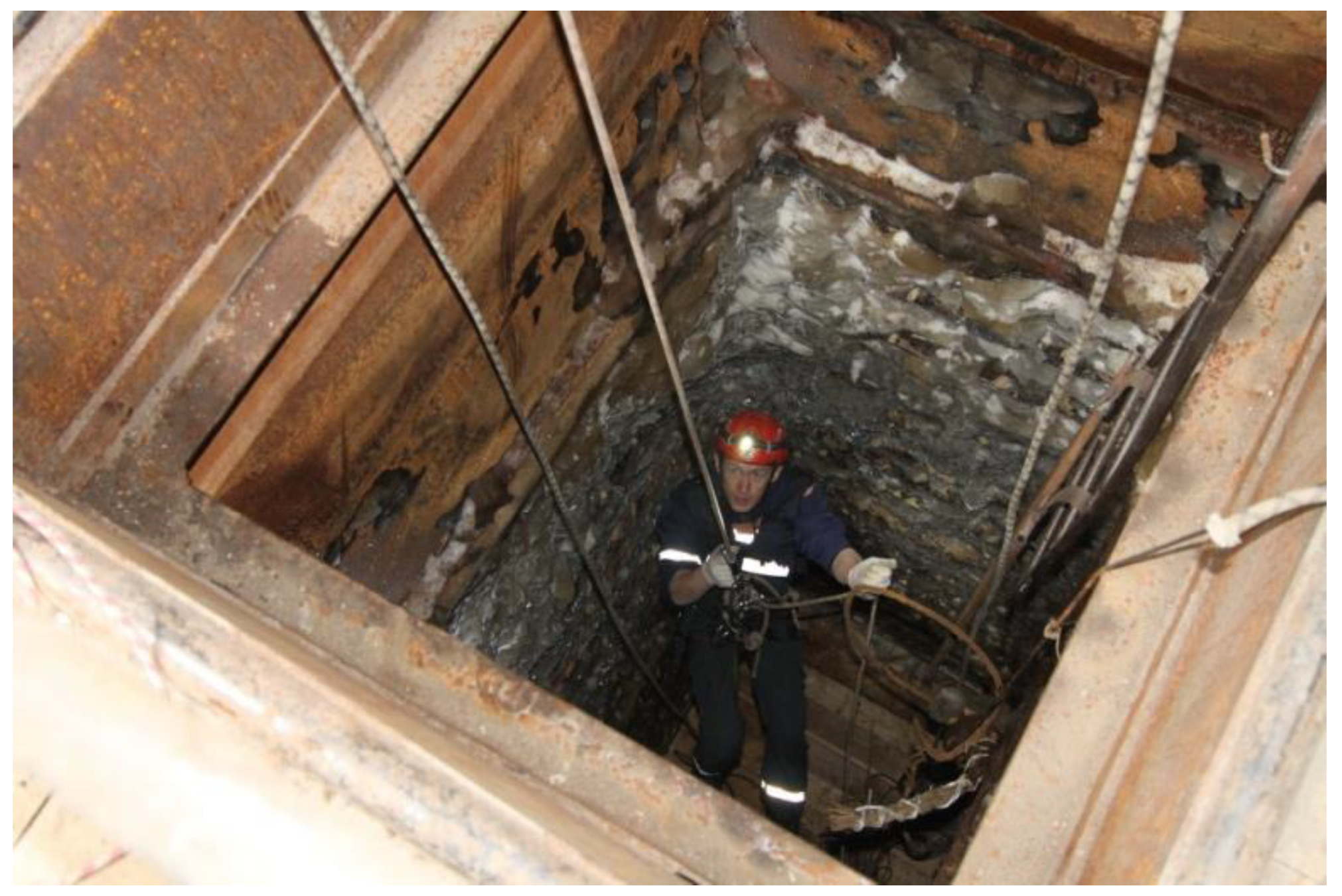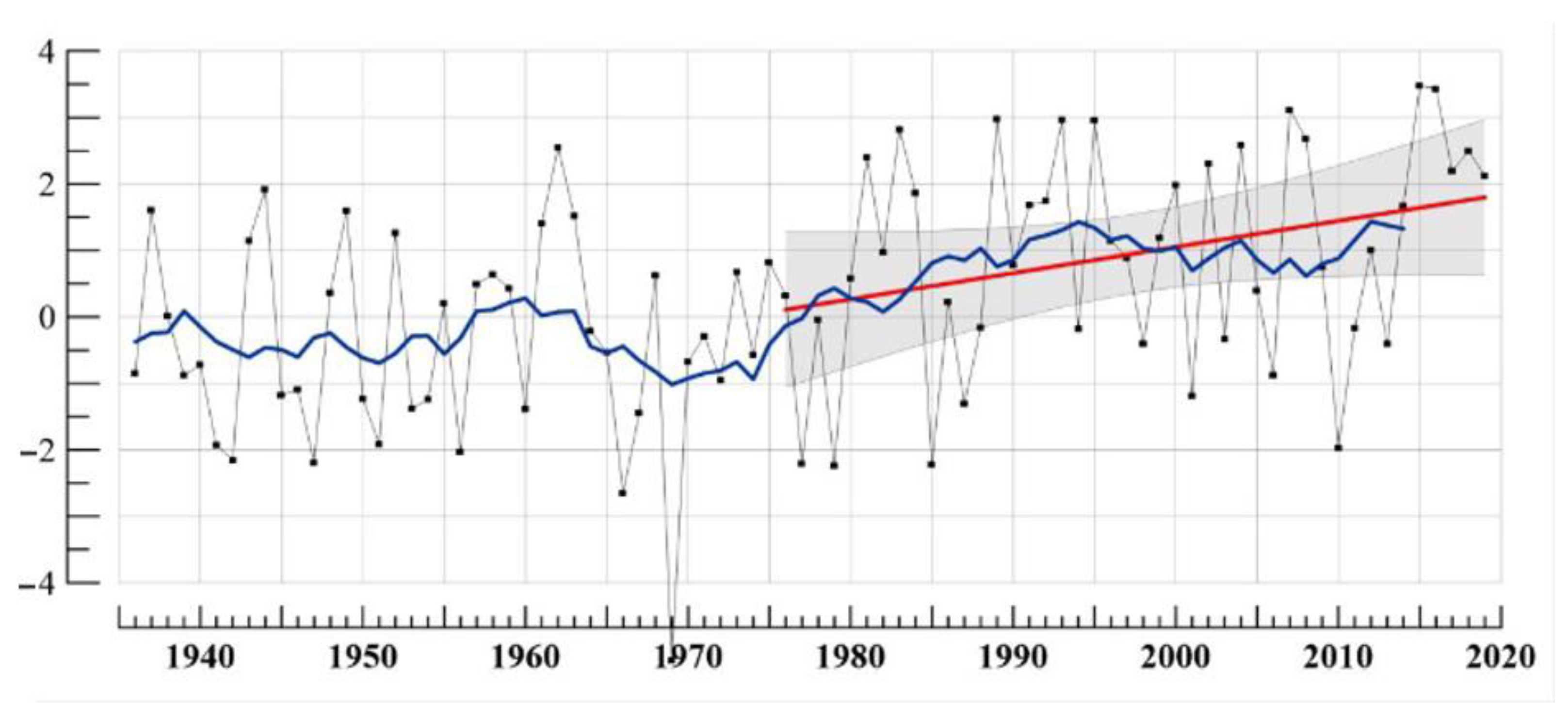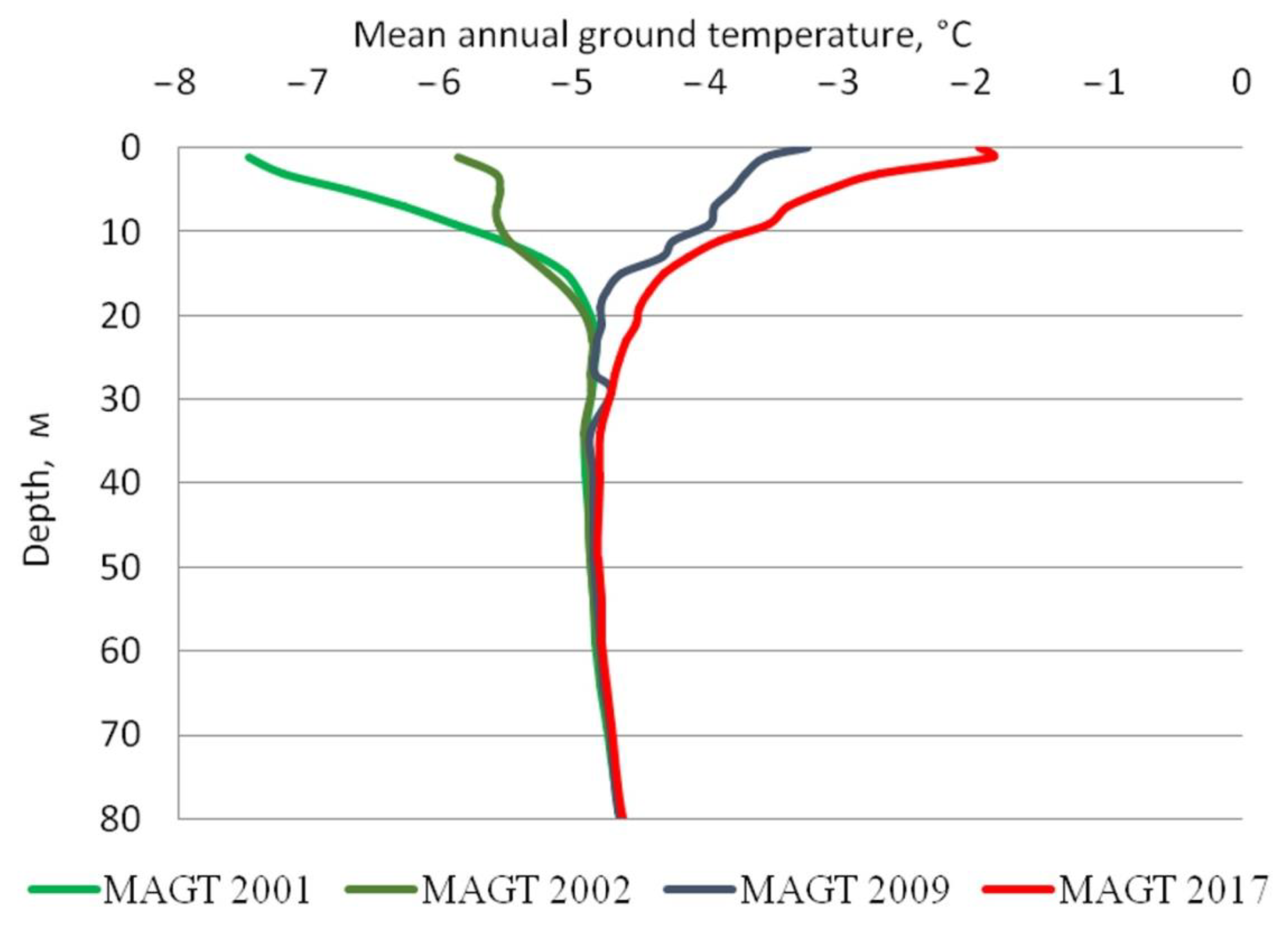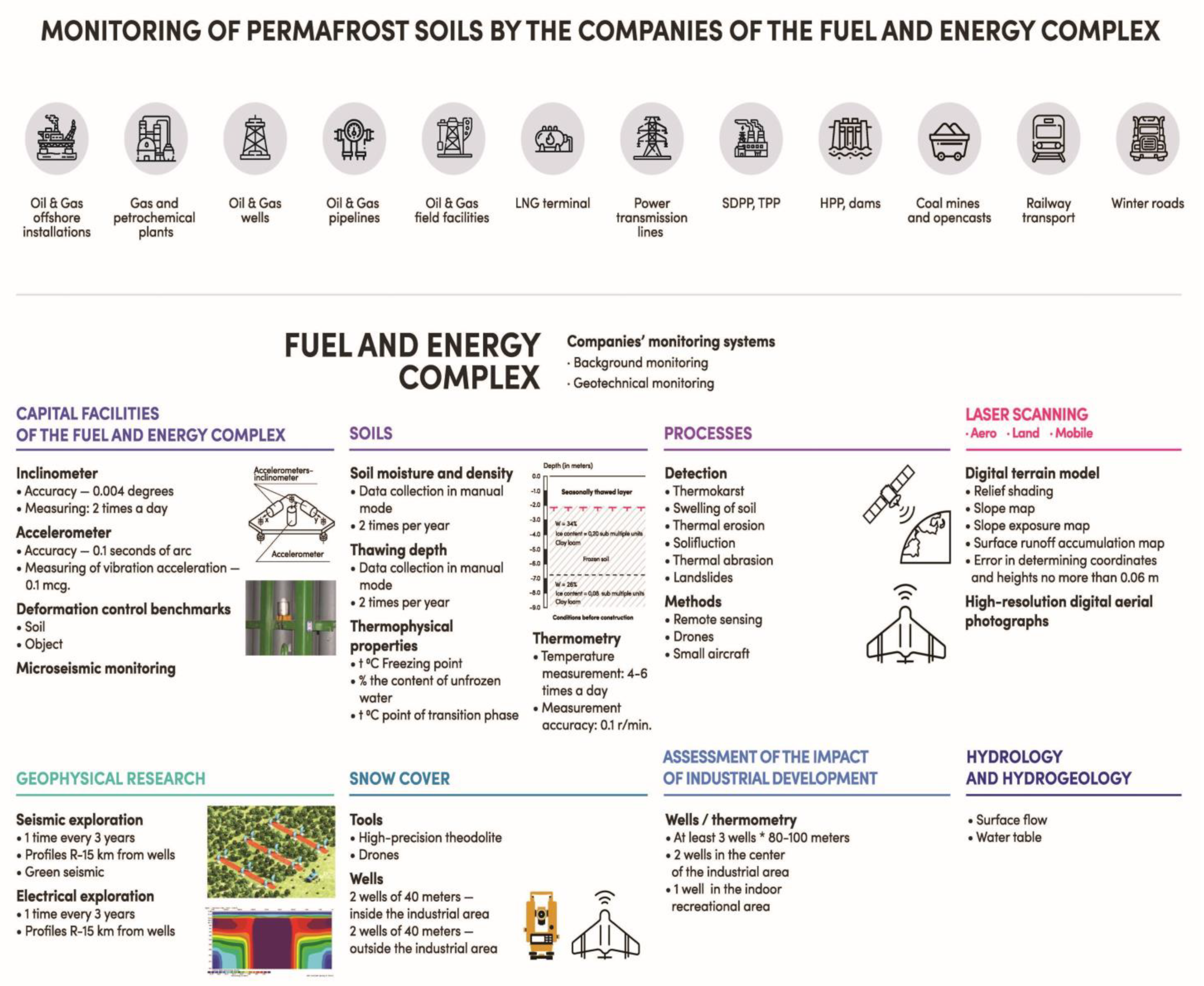Past and Future of Permafrost Monitoring: Stability of Russian Energetic Infrastructure
Abstract
:1. Introduction
2. Background and Basics
3. Organization of Monitoring
3.1. Existing Practice and Experience
3.1.1. Experience of Monitoring Permafrost in the Russian Arctic
3.1.2. Modern Monitoring of Permafrost in Nature
3.1.3. Modern Permafrost Monitoring at Civil and Industrial Facilities
3.2. Permafrost Monitoring Development Concept
3.2.1. Principles of Monitoring
3.2.2. Structure of Monitoring
4. Discussion
5. Conclusions
Author Contributions
Funding
Informed Consent Statement
Acknowledgments
Conflicts of Interest
References
- Zajhhenko, V.M.; Cernyavskij, A.A.; Novikov, N.L.; Novikov, A.N. Strategy for innovative development of electric power in the Arctic zone of Russia. Energy Policy 2018, 4, 68–79. (In Russian) [Google Scholar]
- Balashova, E.S.; Gromova, E.A. Arctic shelf development as a driver of the progress of the Russian energy system. MATEC Web Conf. 2017, 106, 06008. [Google Scholar] [CrossRef] [Green Version]
- Menshikov, S.N.; Morozov, I.S.; Melnikov, I.V. Engineering protection of the objects at the Bovanenkovskoe oil and gas condensate field from the impact of hazardous exogenous processes. Nauka I Tekhnika V Gazov. Promyshlennosti 2014, 58, 14–22. (In Russian) [Google Scholar]
- Melnikov, V.P.; Osipov, V.I.; Brouchkov, A.V.; Falaleeva, A.A.; Badina, S.V.; Zheleznyak, M.N.; Sadurtdinov, M.R.; Ostrakov, N.A.; Drozdov, D.S.; Osokin, A.B.; et al. Climate warming and permafrost thaw in the Russian Arctic: Potential economic impacts on public infrastructure by 2050. Nat. Hazards 2022. [Google Scholar] [CrossRef]
- Melnikov, V.P.; Osipov, V.I.; Brouchkov, A.V.; Badina, S.V.; Velikin, S.A.; Drozdov, D.S.; Dubrovin, V.A.; Zhdaneev, O.V.; Zheleznyak, M.N.; Kuznetsov, M.E.; et al. Decreased sustainability of Russian fuel and energy complex infrastructure in the Arctic as a result of an increase in the average annual temperature of the near-surface layer of the permafrost. Her. Russ. Acad. Sci. 2022, 92, 303–314. [Google Scholar]
- Climate in the Russian Federation in 2018. Rosgidromet Report. Available online: http://global-clima-techange.ru/index.php/ru/component/content/article/2189-doklad (accessed on 17 February 2022). (In Russian).
- Melnikov, V.P.; Osipov, V.I.; Broushkov, A.V. Assessment of damage to residential and industrial buildings and structures during temperature changes and thawing of permafrost soils in the Arctic Zone of the Russian Federation by the middle of the 21st century. Geoekol. Inzhenernaya Geol. Gidrogeol. Geokriol. 2021, 1, 14–31. (In Russian) [Google Scholar]
- Biskaborn, B.K.; Smith, S.L.; Noetzli, J.; Matthes, H.; Vieira, G.; Streletskiy, D.A.; Schoeneich, P.; Romanovsky, V.E.; Lewkowicz, A.G.; Abramov, A.; et al. Permafrost is warming at a global scale. Nat. Commun. 2019, 10, 264. [Google Scholar] [CrossRef] [PubMed] [Green Version]
- Kukkonen, I.T.; Suhonen, E.; Ezhova, E.; Lappalainen, H.; Gennadinik, V.; Ponomareva, O.; Gravis, A.; Miles, V.; Kulmala, M.; Melnikov, V.; et al. Observations and modelling of ground temperature evolution in the discontinuous permafrost zone in Nadym, north-west Siberia. Permafr. Periglac. Process. 2020, 31, 264–280. [Google Scholar] [CrossRef]
- Streletskiy, D.A.; Suter, L.J.; Shiklomanov, N.I.; Porfiriev, B.N.; Eliseev, D.O. Assessment of climate change impacts on buildings, structures and infrastructure in the Russian regions on permafrost. Environ. Res. Lett. 2019, 14, 025003. [Google Scholar] [CrossRef]
- Melnikov, V.P.; Drozdov, D.S.; Pendin, V.V. Arctic Permafrost: Dynamics, Risks, Problems and Solutions. In Proceedings of the 22nd International Science-Practical Conference “New Ideas in Earth Science”, Moscow, Russia, 2–5 April 2015; pp. 123–138. (In Russian). [Google Scholar]
- Ezhova, E.; Orlov, D.; Suhonen, E.; Kaverin, D.; Mahura, A.; Gennadinik, V.; Kukkonen, I.; Drozdov, D.; Lappalainen, H.K.; Melnikov, V.; et al. Climatic Factors Influencing the Anthrax Outbreak of 2016 in Siberia, Russia. EcoHealth 2021, 18, 217–228. [Google Scholar] [CrossRef] [PubMed]
- Drozdov, D.S.; Malkova, G.V.; Romanovsky, V.E.; Vasiliev, A.A.; Leibman, M.O.; Sadurtdinov, M.R.; Ponomareva, O.E.; Pendin, V.V.; Gorobtsov, D.N.; Ustinova, E.V.; et al. Digital maps of permafrost zone and assessment of current trends of cryosphere changes. In 9 International Symposium on Permafrost Engineering. Book of Abstract; Melnikov Permafrost Institute SB RAS Press: Yakutsk, Russia, 2017; pp. 32–33. (In Russian) [Google Scholar]
- Middendorf, A.F. Journey to the North and East of Siberia: In Two Parts; Imperial Academy of Sciences: Saint-Petersburg, Russia, 1860–1878. (In Russian) [Google Scholar]
- Sumgin, M.I. Permafrost of Soil within the USSR; Nauka: Moscow, Russia, 1937. (In Russian) [Google Scholar]
- Pavlov, A.V. Frost-climate monitoring of Russia: Methodology, observation results, forecast. Kriosf. Zemli Earth’s Cryosphere 1997, 1, 47–58. (In Russian) [Google Scholar]
- Baranov, I.Y. Principles of Geocrycological (Permafrost) Zoning of the Region of Permafrost Rocks; Nauka: Moscow, Russia, 1965. (In Russian) [Google Scholar]
- Baulin, V.V. Permafrost of the Oil and Gas-Bearing Regions of the USSR; Nedra: Moscow, Russia, 1985. (In Russian) [Google Scholar]
- Melnikov, E.S.; Greschischev, S.E. (Eds.) Permafrost and Development of Oil and Gas-Bearing Areas; Geos: Moscow, Russia, 2002. (In Russian) [Google Scholar]
- Ershov, E.D. (Ed.) Geocryological Map of the USSR on the Scale of 1:2,500,000; GUGK: Moscow, Russia, 1991. (In Russian) [Google Scholar]
- Melnikov, E.S. (Ed.) Geocryological Conditions of the West Siberian Gas-Bearing Province; Nauka: Novosibirsk, Russia, 1983. (In Russian) [Google Scholar]
- Baulin, B.B.; Belopuhova, K.B.; Dubkov, G.I.; Shmelev, L.M. (Eds.) Geocryological Conditions of the West Siberian Lowland; Nauka: Moscow, Russia, 1967. (In Russian) [Google Scholar]
- Ershov, E.D. (Ed.) Geocryology of the USSR. European Territory of the USSR; Nedra: Moscow, Russia, 1988. (In Russian) [Google Scholar]
- Ershov, E.D. (Ed.) Geocryology of the USSR. Western Siberia; Nedra: Moscow, Russia, 1989. (In Russian) [Google Scholar]
- Drozdov, D.S. Electronic maps of natural geocryosystems as the basis of the system of territorial monitoring of the geological environment of the Bovanenkovsky and Zapolyarnoye deposits. In Geo-Environmental Mapping: Part 3; Geoinformmark: Moscow, Russia, 2001; pp. 89–91. (In Russian) [Google Scholar]
- Manual for Monitoring and Reporting Permafrost Measurements. Part I: Permafrost Borehole Temperatures: Thermal State of Permafrost (TSP). Part II: Active Layer: Circumpolar Active Layer Monitoring (CALM). International Permafrost Association (IPA). 2008. Available online: https://permafrost.gi.alaska.edu/sites/default/files/TSP_manual.pdf (accessed on 3 April 2022).
- Drozdov, D.S.; Malkova, G.V.; Ukraintseva, N.G.; Korostelev, Y.V. Permafrost Monitoring of Southern Tundra Landscapes in the Russian European North and West Siberia. In Tenth International Conference on Permafrost; The Northern Publisher: Salekhard, Russia, 2012; Volume 2, pp. 65–70. (In Russian) [Google Scholar]
- Melnikov, V.P. (Ed.) Complex Monitoring of Northern Taiga Geosystems in the Western Siberia; Nauka: Novosibitsk, Russia, 2012. (In Russian) [Google Scholar]
- Tsytovich, N.A. The Mechanics of Frozen Ground; McGraw-Hill Book Company: New York, NY, USA, 1975. [Google Scholar]
- Saltykov, N.I. Buiding Foundations in Yakutsk; Permafrost Institute: Moscow, Russia, 1946; Volume 1, pp. 102–136. (In Russian) [Google Scholar]
- Bardin, M.Y. (Ed.) Review of Condition and Trends of Climate Change in Russia; Rosgidromet; RAS: Moscow, Russia, 2019. (In Russian) [Google Scholar]
- Hardware and Software Measuring Complex Based on Loggers LPC; Geotechcenter: Moscow, Russia, 2006.
- Digital Sensor Controllers Portable PKCD-1/100; Etalon: Omsk, Russia, 2010. (In Russian)
- Zhdaneev, O.V. (Ed.) Technical Policy Issues of the Russian Federation Fuel and Energy Complex Branches; Nauka: Moscow, Russia, 2020. (In Russian) [Google Scholar]
- Rivkin, F. Integrated regional monitoring methodology. In Modern Research on Cryosphere Transformation and Issues of Geotechnical Safety of Structures in the Arctic; Arctic Science Center: Salekhard, Russia, 2021. (In Russian) [Google Scholar]
- Kronik, Y.A. Reliability and Safety of the Foundations of Buildings and Structures on Permafrost. Soil Mech. Found. Eng. 2017, 54, 198–202. [Google Scholar] [CrossRef]
- Grebenets, V.; Streletskiy, D.; Shiklomanov, N. Geothecnical safety issues in the cities of Polar regions. Geogr. Environ. Sustain. 2012, 5, 104–119. [Google Scholar] [CrossRef] [Green Version]
- Zhdaneev, O.V.; Frolov, K.N.; Konygin, A.E.; Gekhaev, M.R. Exploration Drilling on the Arctic and Far Eastern Shelf of Russia. Arct. Ecol. Econ. 2020, 39, 112–125. (In Russian) [Google Scholar]
- Streletskaya, I.D.; Leibman, M.O. (Eds.) Russian permafrost map index. In Workshop on Permafrost Data Rescue and Access; Glaciological Data, Report GD-28; World Data Center for Glaciology: Washington, DC, USA, 1995; pp. 33–114. [Google Scholar]
- Yershov, E.D. General Geocryology; Cambridge University Press: Cambridge, UK, 1998. [Google Scholar]
- Karjalainen, O.; Aalto, J.; Luoto, M.; Westermann, S.; Romanovsky, V.E.; Nelson, F.E.; Etzelmüller, B.; Hjort, J. Circumpolar permafrost maps and geohazard indices for near-future infrastructure risk assessments. Sci. Data 2019, 6, 190037. [Google Scholar] [CrossRef] [PubMed] [Green Version]
- Drozdov, D.S.; Dubrovin, V.A. Environmental problems of oil and gas exploration and development in the Russian Arctic. Kriosf. Zemli 2016, 10, 14–25. (In Russian) [Google Scholar]
- Dubrovin, V.A.; Broushkov, A.V.; Drozdov, D.S.; Zheleznyak, M.N. Study, current state, prospects and problems of Arctic cryolithozone development. Mineral resources of Russia. Econ. Manag. 2019, 166, 55–64. (In Russian) [Google Scholar]
- Harris, S.; Brouchkov, A.; Cheng, G. Geocryology: Characteristics and Use of Frozen Ground and Permafrost Landforms; CRC Press: London, UK, 2018. [Google Scholar] [CrossRef]
- Khrustalev, L.N.; Parmuzin, S.Y.; Emelyanova, L.V. Stability of Northern Infrastructure under Changing Climate; Universitetskaya Kniga: Moscow, Russia, 2011. (In Russian) [Google Scholar]
- Kudryavtsev, V.A.; Melamed, V.G.; Garagula, L.S. Fundamentals of Frost Forecasting in Geotechnical Research; Moscow University: Moscow, Russia, 2016. (In Russian) [Google Scholar]
- The Global Terrestrial Network for Permafrost (GTN-P). Available online: https://gtnp.arcticportal.org/ (accessed on 4 January 2022).
- Alverson, K.; Ryan, B. (Eds.) Integrated Global Observing Strategy Cryosphere Theme Report—For the Monitoring of our Environment from Space and from Earth; World Meteorological Organization: Geneva, Switzerland, 2007. [Google Scholar]





Publisher’s Note: MDPI stays neutral with regard to jurisdictional claims in published maps and institutional affiliations. |
© 2022 by the authors. Licensee MDPI, Basel, Switzerland. This article is an open access article distributed under the terms and conditions of the Creative Commons Attribution (CC BY) license (https://creativecommons.org/licenses/by/4.0/).
Share and Cite
Melnikov, V.P.; Osipov, V.I.; Brouchkov, A.V.; Badina, S.V.; Sadurtdinov, M.R.; Drozdov, D.S.; Malkova, G.V.; Zheleznyak, M.N.; Zhdaneev, O.V.; Ostarkov, N.A.; et al. Past and Future of Permafrost Monitoring: Stability of Russian Energetic Infrastructure. Energies 2022, 15, 3190. https://doi.org/10.3390/en15093190
Melnikov VP, Osipov VI, Brouchkov AV, Badina SV, Sadurtdinov MR, Drozdov DS, Malkova GV, Zheleznyak MN, Zhdaneev OV, Ostarkov NA, et al. Past and Future of Permafrost Monitoring: Stability of Russian Energetic Infrastructure. Energies. 2022; 15(9):3190. https://doi.org/10.3390/en15093190
Chicago/Turabian StyleMelnikov, Vladimir P., Victor I. Osipov, Anatoli V. Brouchkov, Svetlana V. Badina, Marat R. Sadurtdinov, Dmitry S. Drozdov, Galina V. Malkova, Mikhail N. Zheleznyak, Oleg V. Zhdaneev, Nikolay A. Ostarkov, and et al. 2022. "Past and Future of Permafrost Monitoring: Stability of Russian Energetic Infrastructure" Energies 15, no. 9: 3190. https://doi.org/10.3390/en15093190
APA StyleMelnikov, V. P., Osipov, V. I., Brouchkov, A. V., Badina, S. V., Sadurtdinov, M. R., Drozdov, D. S., Malkova, G. V., Zheleznyak, M. N., Zhdaneev, O. V., Ostarkov, N. A., Osokin, A. B., Sergeev, D. O., Dubrovin, V. A., Kuznetsov, M. E., Frolov, K. N., Alekseev, A. G., & Fedorov, R. Y. (2022). Past and Future of Permafrost Monitoring: Stability of Russian Energetic Infrastructure. Energies, 15(9), 3190. https://doi.org/10.3390/en15093190









